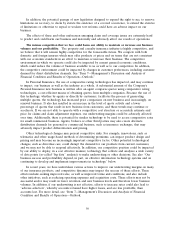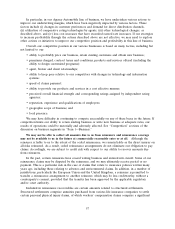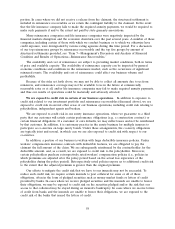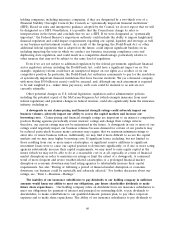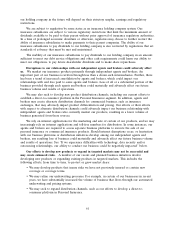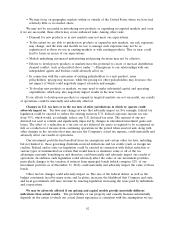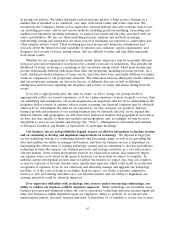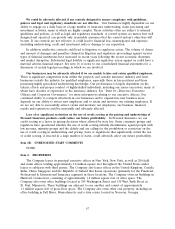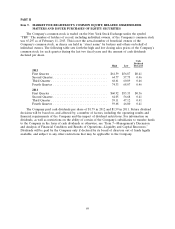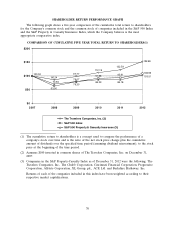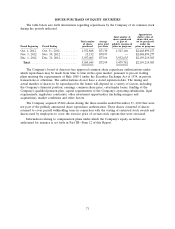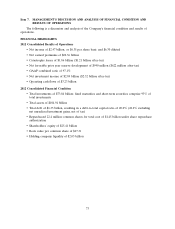Travelers 2012 Annual Report Download - page 75
Download and view the complete annual report
Please find page 75 of the 2012 Travelers annual report below. You can navigate through the pages in the report by either clicking on the pages listed below, or by using the keyword search tool below to find specific information within the annual report.in pricing our policies. We utilize third-party and proprietary models to help us price business in a
manner that is intended to be consistent, over time, with actual results and return objectives. We
incorporate the Company’s historical loss experience, external industry data and economic indices into
our modeling processes, and we use various methods, including predictive modeling, forecasting and
sophisticated simulation modeling techniques, to analyze loss trends and the risks associated with our
assets and liabilities. We also use these modeling processes, analyses and methods in making
underwriting, pricing and reinsurance decisions as part of managing our exposure to catastrophes and
other extreme adverse events. These modeling processes incorporate numerous assumptions and
forecasts about the future level and variability of: interest rates, inflation, capital requirements, and
frequency and severity of losses, among others, that are difficult to make and may differ materially
from actual results.
Whether we use a proprietary or third-party model, future experience may be materially different
from past and current experience incorporated in a model’s forecasts or simulations. This includes the
likelihood of events occurring or continuing or the correlation among events. Third party models may
provide substantially different indications than what our proprietary modeling processes provide. As a
result, third-party model estimates of losses can be, and often have been, materially different for similar
events in comparison to our proprietary estimates. The differences between third-party model estimates
and our proprietary estimates are driven by the use of different data sets as well as different
assumptions and forecasts regarding the frequency and severity of events and claims arising from the
events.
If we fail to appropriately price the risks we insure, or fail to change our pricing model to
appropriately reflect our current experience, or if our claims experience is more frequent or severe than
our underlying risk assumptions, our profit margins may be negatively affected. If we underestimate the
frequency and/or severity of extreme adverse events occurring, our financial condition may be adversely
affected. If we overestimate the risks we are exposed to, we may overprice our products, and new
business growth and retention of our existing business may be adversely affected. As we expand into
different markets and geographies, we will write more policies in markets and geographical areas where
we have less data specific to these new markets and geographies, and, accordingly, we may be more
susceptible to error in our models and strategy. See ‘‘Item 7—Management’s Discussion and Analysis
of Financial Condition and Results of Operations—Catastrophe Modeling.’’
Our business success and profitability depend, in part, on effective information technology systems
and on continuing to develop and implement improvements in technology. We depend in large part
on our technology systems for conducting business and processing claims, as well as for providing the
data and analytics we utilize to manage our business, and thus our business success is dependent on
maintaining the effectiveness of existing technology systems and on continuing to develop and enhance
technology systems that support our business processes and strategic initiatives in a cost and resource
efficient manner. Some system development projects are long-term in nature, may negatively impact
our expense ratios as we invest in the projects and may cost more than we expect to complete. In
addition, system development projects may not deliver the benefits we expect once they are complete,
or may be replaced or become obsolete more quickly than expected, which could result in accelerated
recognition of expenses. If we do not effectively and efficiently manage and upgrade our technology
portfolio, or if the costs of doing so are higher than we expect, our ability to provide competitive
services to new and existing customers in a cost effective manner and our ability to implement our
strategic initiatives could be adversely impacted.
If we experience difficulties with technology, data security and/or outsourcing relationships, our
ability to conduct our business could be negatively impacted. While technology can streamline many
business processes and ultimately reduce the cost of operations, technology initiatives present significant
risks. Our business is highly dependent upon our employees’ ability to perform, in an efficient and
uninterrupted fashion, necessary business functions. A shut-down of, or inability to access, one or more
63





